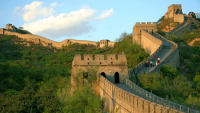Japan and South Korea Dispute over Forced Laborers after UNESCO's Recognition of 23 Meiji Sites
| Kwao Peppeh | | Jul 07, 2015 10:58 AM EDT |
(Photo : Reuters) Eighty-two-year-old Hong Kong protester Lu Xuemen (C), who survived being a slave labour and the world's first atomic bombing in Hiroshima, protest with a group of Japanese activists in Hong Kong August 6, 2001, against Japan-based Nishimatsu Construction for allegedly forcing 50,000 Chinese into slave labour during World War Two. Nishimatsu declined to comment in Hong Kong. The company has been involved with several key infrastructure projects including the construction of the city's state-of-the-art airport.
The United Nations Educational, Scientific and Cultural Organization (UNESCO) added 23 Japanese sites to its compendium of World Heritage sites on Sunday. UNESCO bestowed the World Heritage status on the sites located at 11 different locations in the country because they best represented the country's rapid pace of industrial development during the reign of Emperor Meiji.
Like Us on Facebook
The Japanese sites, especially those located in the southwest of the country, were reportedly chosen because the facilities, which include a shipbuilding yard, a coal mine and a steelworks, spurred the country's industrialization from the middle of the 19th century to the 20th century.
However, according to the Wall Street Journal, Tokyo's bid sparked controversy as Seoul argued that at least seven of the facilities were used as deportation centers where Koreans endured years of forced labor during Japan's occupation of China and South Korea.
Before UNESCO reached a decision during a meeting in Germany on Sunday, South Korea's delegation required that Japan acknowledges Korean forced laborers played a role in building some of the sites.
The Japanese representative Kuni Sato accepted that a large number of Koreans and other nationals "were brought against their will and were forced to work under severe conditions" during the 1940s in some of the country's industrial sites.
The Japanese delegation also said the country was willing to honor the victims by creating an information center, where they would be remembered. Seoul puts the number of workers at around 57,000.
South Korea's foreign ministry welcomed the admission, saying that the comments were first time Tokyo has mention or acknowledged that fact that Koreans were taken against their will and forced to work under dire conditions.
Although the agreement was seen as victory for diplomacy, Seoul's remarks did not go down well with many in Japan, who view the outcome of the meeting as a diplomatic defeat.
On Tuesday, Foreign Minister Fumio Kishida said at a press conference that the country's UNESCO delegation "does not acknowledge that there was forced labor" in the centers.
Korea Observer reports that Chief Cabinet Secretary Youshihide Suga said that although Koreans were forced to work in the facilities, they were not "forced laborers."
According to Global Times, although Japan admitted using forced workers from Korea and other countries, several analysts are still unsure of what stand the Japanese government is taking on history - especially during that period.
"The acknowledgement is in fact a compromise the Japanese government made to South Korea. This does not mean that there is a fundamental change in Japan's stance toward all of its wartime history," said Liu Jiangyong, vice dean of the Institute of Modern International Relations at Tsinghua University.
Reports indicate that hundreds of Chinese nationals were also forced to work on some of the UNESCO listed sites during World War II. Most Chinese forced laborers worked in a Nagasaki coal mine.
China's Ministry of Foreign Affairs spokesperson Hua Chunying said Monday that Chinese authorities were aware of UNESCO's decision. She added that Japan must fulfill its pledge and use it actions to gain the trust of neighboring Asian states and the world in general.
"The real issue is not whether those sites are listed or not, but about Japan's attitude on it's wartime past and whether it would see [the World Heritage status] to honor its previous aggression," Liu explained.
TagsUNESCO Japan Meiji Sites, Japan World War II Forced Labour, UNESCO World Heritage Sites Japan
©2015 Chinatopix All rights reserved. Do not reproduce without permission
EDITOR'S PICKS
-

Did the Trump administration just announce plans for a trade war with ‘hostile’ China and Russia?
-

US Senate passes Taiwan travel bill slammed by China
-

As Yan Sihong’s family grieves, here are other Chinese students who went missing abroad. Some have never been found
-

Beijing blasts Western critics who ‘smear China’ with the term sharp power
-

China Envoy Seeks to Defuse Tensions With U.S. as a Trade War Brews
-

Singapore's Deputy PM Provides Bitcoin Vote of Confidence Amid China's Blanket Bans
-

China warns investors over risks in overseas virtual currency trading
-

Chinese government most trustworthy: survey
-

Kashima Antlers On Course For Back-To-Back Titles
MOST POPULAR
LATEST NEWS
Zhou Yongkang: China's Former Security Chief Sentenced to Life in Prison

China's former Chief of the Ministry of Public Security, Zhou Yongkang, has been given a life sentence after he was found guilty of abusing his office, bribery and deliberately ... Full Article
TRENDING STORY

China Pork Prices Expected to Stabilize As The Supplies Recover

Elephone P9000 Smartphone is now on Sale on Amazon India

There's a Big Chance Cliffhangers Won't Still Be Resolved When Grey's Anatomy Season 13 Returns

Supreme Court Ruled on Samsung vs Apple Dispute for Patent Infringement

Microsoft Surface Pro 5 Rumors and Release Date: What is the Latest?













